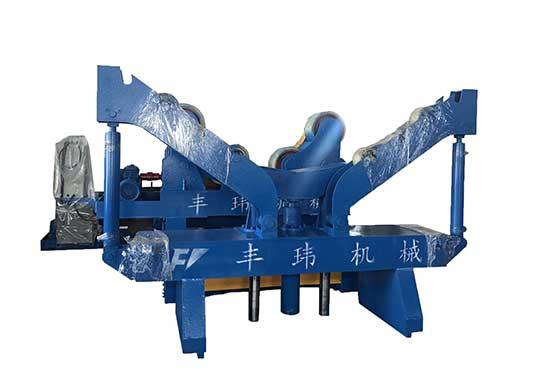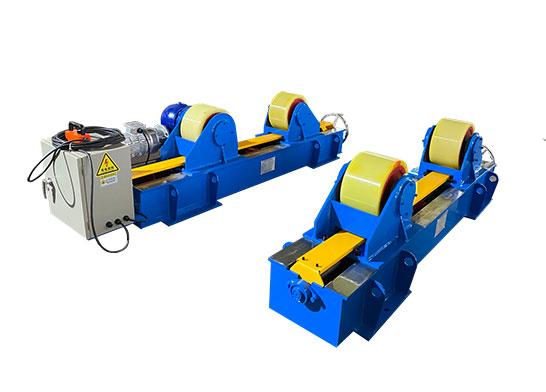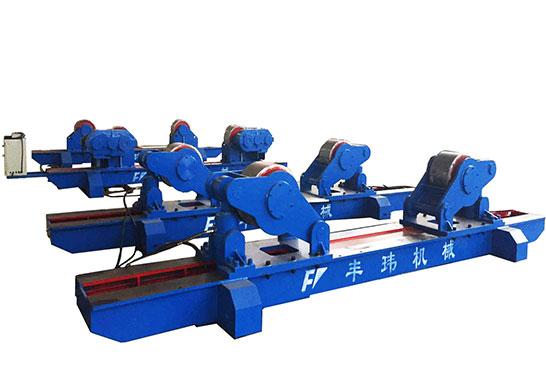Welding Rotator | Wind Tower Production Line
A welding rotator is a piece of auxiliary welding gear. It uses friction between the welding material and the roller to rotate the cylindrical or conical welding material. Welding rotator is frequently used in conjunction with welding manipulators. They can weld the inner and outer lengthy seams as well as the inner and outer radial seams of cylindrical metal components.
-
Model
Adjustable\Self-aligned\Fit up\Growing line
-
Loading Capacity (kg)
1,000 - 3,000,000 above
-
Roller Material
PU or Metal
A welding rotator is a piece of auxiliary welding gear. It uses friction between the welding material and the roller to rotate the cylindrical or conical welding material. Welding rotator is frequently used in conjunction with welding manipulators. They can weld the inner and outer lengthy seams as well as the inner and outer radial seams of cylindrical metal components.
Welding rotators have a lot of merits.
Because of the improved production rate, better welding quality, higher business ROI, and other factors, the adoption of rotary welding tables in the industrial business has skyrocketed. Welders' welding efforts are reduced by these welding tables, which provide easy access to the entire welding workpiece. Increased production rate and improved welding quality pay for the investment to a large extent.
· The quality of welding has improved.
By letting the professional to weld at the required position by rotating the positioner to that point, rotary welding panels improve welding grade. These panels allow welders to change the angles and heights of the surface. As a result, the visibility of the welder improves, fatigue decreases, and the task is easier to repeat. All of the advantages contribute to the workpiece's higher quality. You may be sure that the quality of the welds will be higher, more exact, and precise if you automate the movement or rotation of the workpieces.
· Less effort for welders
You will have less effort if you utilize a welding rotator because it will spin automatically. This process removes the need for a welder to physically move and rotate the workpiece, ensuring the welder's and the workpiece's safety and security.
· Increased production rate:
This is the most important consideration for any company looking to include rotary welding in their manufacturing process. Any organization adopting the positioner is motivated by the need to improve welding quality and productivity. Companies are educating their personnel to be more efficient, which leads to higher production rates. The rotary welding positioner is the instrument to invest in to increase production rates by improving repeatability, welding quality, and efficiency. The instrument allows highly skilled workers to better their welding by eliminating the need to travel to the welding site to be transported to the worker.
· Automation process
Welding rotators aid in the automation of welding operations. Without the need for an operator, the workpiece can be handled, twisted, rotated, and maneuvered. Of course, this assumes the presence of other welding tool and machinery. For example, if it operates in tandem with a welding manipulator, it might be considered one of the tools that aid in welding automation.
· It gives stronger and more reliable support.
The equipment's support is sufficient to label it as having better and more reliable assistance. This can prevent deformation of the workpiece, its quality, and its overall dimensions.
· Greater safety
Rotary welding tables increase worker safety on the factory floor, particularly when positioning heavy products to be welded. Another advantage of rotating welding tables is that welders do not need to utilize ladders or lifts to reach higher workpiece heights, reducing the danger of accidents on the shop floor. Cranes and forklifts were previously utilized to rotate any workpiece, which was inefficient and resulted in worker injuries. Still, rotary welding tables have decreased this risk by providing a revolving surface. Workers spend a lot of time learning how to position workpieces on older machines, but with these rotary tables, anyone can learn how to position workpieces in a matter of hours.
What are the different components of a welding rotator?
There are two elements to a typical welding rotator. Each of them would have different sections if dissected, and they are listed below.
Supporting unit for idler
The idler support, often known as the base, is the component that supports the wheels or media that conduct the workpiece's rotation or twisting. The idler support unit is made up of the two variables:
· Turning roll to drive
· Wheel frame with a drive
Drive unit with a motor
The motorized drive unit is the rotator that emits the power and energy needed to make the welding rotator work to everyone's advantage. Like the idler supporting unit, the motorized drive unit is made up of several sections and components. Two of the most outstanding components of the motorized drive unit are the controller and the motor.
Uses for welding rotators
In the welding industry, a welding rotator can be utilised in a variety of ways. Welding rotators are used to make a variety of items, including storage and pressure vessels. One of the most primary operations is to weld the following components:
· Tanks for storage
· Water storage tanks
· Shipyards and ship components
· Vessels under pressure
Different types of welding rotators
Welding rotators are not confined to a single machine model, contrary to popular belief. The fit-up welding rotator is one of the most recurrent types of welding rotators. In reality, there are many different sorts and types of welding rotators available today.
· Adjustable turning rolls
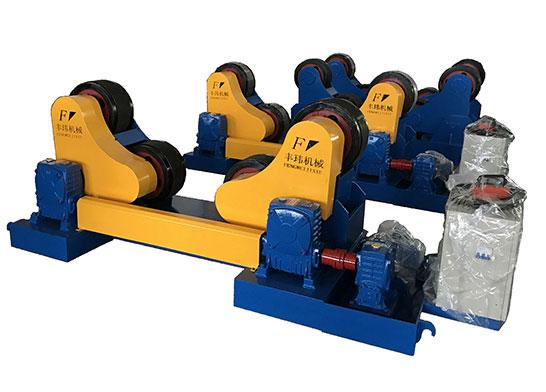
Welding rotators have turning rolls that may easily be changed to fit the circumference and width of the product or material being welded.
· Fit up welding rotators
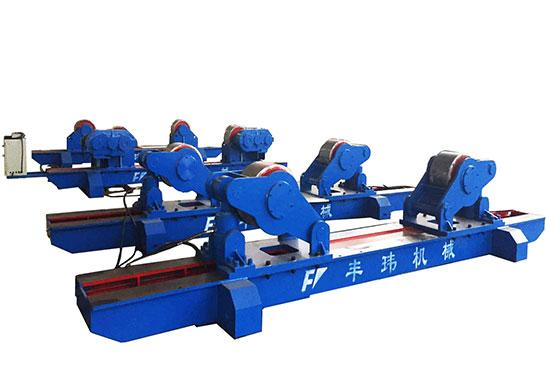
Fit up welding rotators, like adjustable rotating rollers it is adjusted to fit the size of the workpiece. This is to guarantee that the weld is accurate and precise.
· Rotators for pipe pinching
As the name implies, Pipe pinching rotators are a sort of welding rotator that clamps onto a pipe or any other cylindrical item and assists in the automatic welding process.
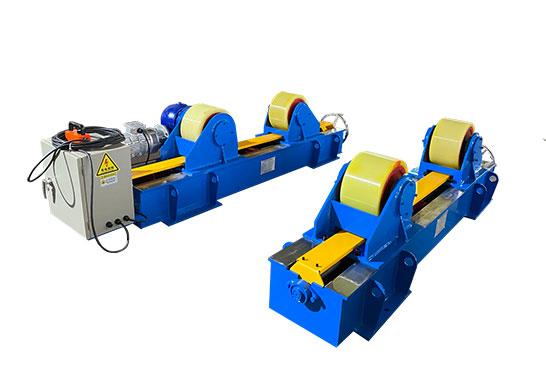
· Welding rotators that self-align
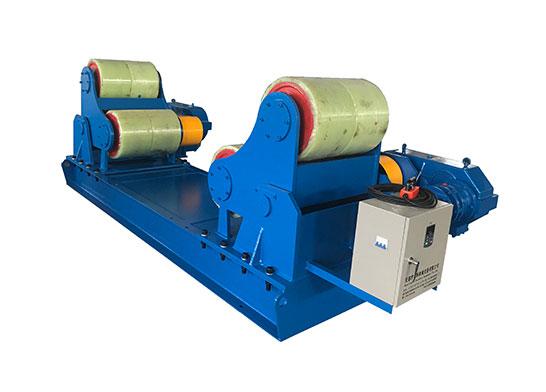
Self-aligning are welding rotators are fully automated when it comes to aligning and balancing workpieces.
Bottom line
Using a welding rotator can increase output while reducing labor costs because it involves less lifting or crane utilization, decreasing idle time, and increasing job efficiency. You can contact Fengwei to know the product in detail and they will assist you in determining which welding rotator is best for your project and give you the most cost-effective solution.
Wind Tower Production Line
-
Self-adjusting Welding rotator|Safety Operation Guide
Fengwei has 20 years of experience in the design and development of welding rotators, among which the self-adjusting welding rotator has been recognized by partners from all over the world.
self-adjusting welding rotator -
welding rotator|US hot sale
Fengwei is a professional in the manufacture and research and development of welding rotators. Various types of welding rotators have been recognized in the welding application fields of various large-scale equipment in the United States.
welding rotators -
Welding Roller | Welding rotator manufacturer
Welding rollers play a crucial role in the structure of welding rotators. Different materials of rollers have unnecessary welding auxiliary effects. The most important one is the anti-slip effect of welding rotators.
Welding rollers -
The Best Quality Self Adjusting Welding Rotator From China
Self-adjusting welding rotator is a kind of equipment used with a welding manipulator, which is used to support or drive rotation when welding straight seams and circumferential seams of pressure vessels and large-diameter pipes.
Self-adjusting welding rotator -
Improve Weld Quality|Welding Rotator
The welding rotator belongs to welding auxiliary equipment. It is often used for cylindrical workpieces, inner and outer rings, or inner and outer horizontal welding.
welding rotator -
Adjustable Welding Rotator - Explosion-Proof & Anti-Channeling
The adjustable welding rotator consists of a driving frame and a driven frame as a set and generally does not need to make an installation foundation.
welding rotator





